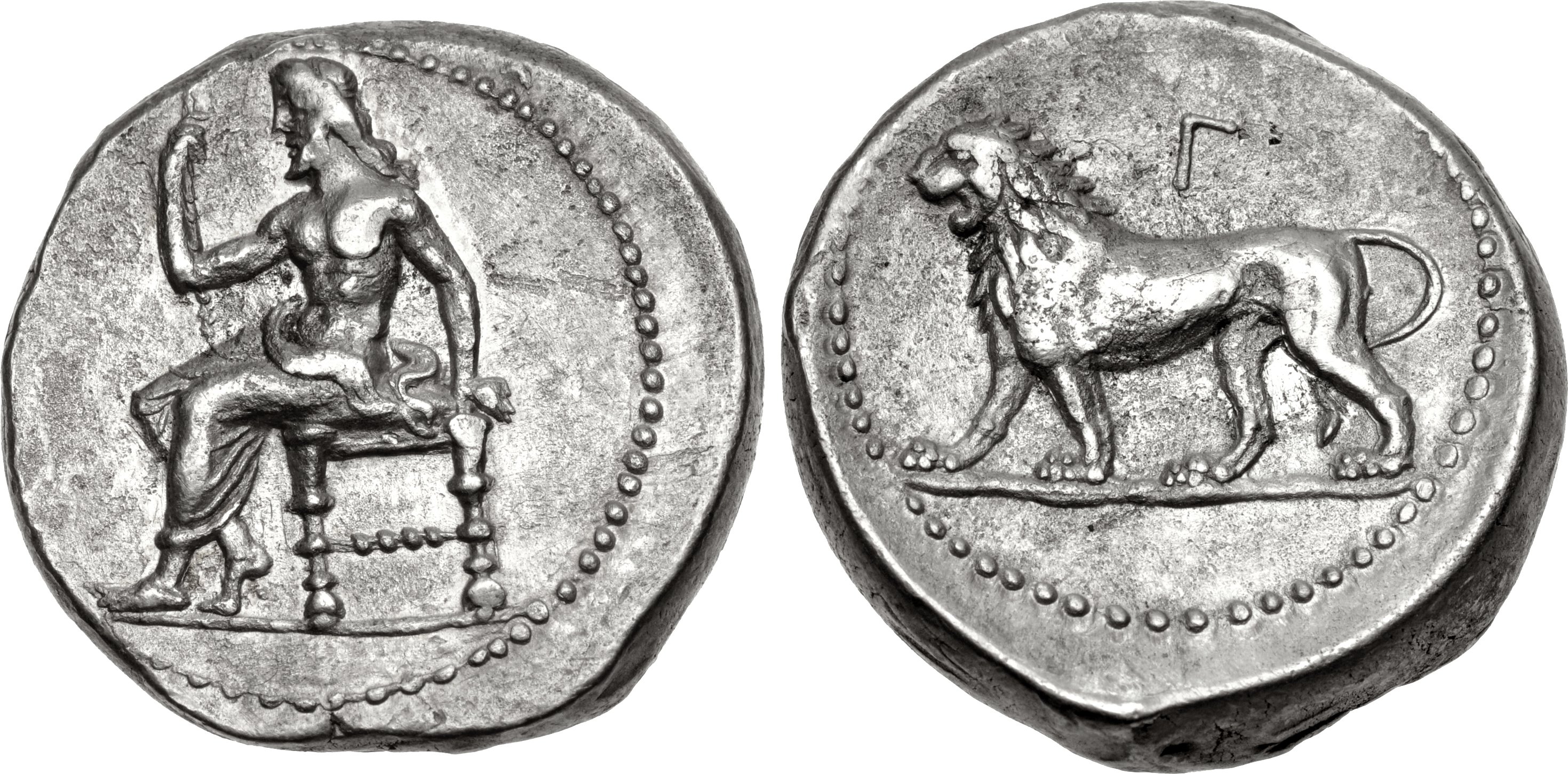Babylon (Seleucus I), silver, staters (seated Baal/lion) (321-315 BCE)
From SILVER
(Redirected from S 1893 - Babylon (Seleucus I), silver, staters (321-315 BCE))
321 BCE - 315 BCE Silver 31,521 kg
Description
| ObverseInscription or printing placed on the obverse.: | Baal seated left, holding scepter in right hand, left hand on throne |
| ReverseInscription or printing placed on the reverse.: | Lion advancing left, Γ above |
Mint and issuing power
| MintIdentifies the place of manufacture or issue of a numismatic object.: | Babylon | Ancient regionAncient region.: | Mesopotamia | Modern countryModern country: Iraq | AuthorityIdentifies the issuing power. The authority can be "pretended" when the name or the portrait of X is on the coin but he/she was not the issuing power. It can also be "uncertain" when there is no mention of X on the coin but he/she was the issuing power according to the historical sources: | Seleucid Dynasty (312-63 BC), Seleucus I Nicator (satrap in 321-305 BC and Seleucid king in 305-281 BC) |
Chronology
| FromIdentifies the initial date in a range assigned in a numismatic context. | 321 BCE | toIdentifies the final date in a range assigned in a numismatic context.. | 315 BCE | PeriodTime period of the numismatic object.: Hellenistic 323-30 BC |
Physical description
| MetalThe physical material (usually metal) from which an object is made.: | Silver |
Median weightMedian of the weights of numismatic objects (in grams). in grams | 15.60 | DenominationTerm indicating the value of a numismatic object. Examples: tetradrachm, chalkous, denarius.: | stater |
StandardStandard.: | Persian |
Image

S1893 Babylon (Seleucus I) staters lion.jpg [1]
References
| Die study referencePublication of the study: | Iossif - Lorber 20071Iossif - Lorber 2007, p. 9-11 | ||
| Coin series referenceReference to coin series study: | ESM2ESM, n° 262, HGC 93HGC 9, n° 67, SC I4SC I, n° 88 | ||
| Coin series web referenceCoin series web references: | |||
Obverse dies distribution
| FrequencyFrequency of specimen in distribution. ᵖ | Number of obversesNumber of obverse dies. ᵖ (o) | % (o) | Number of coinsNumber of coins. (n) | % (n) | Die nameName(s) of the die(s). |
| 1 | 31 | 54.39 | 31 | 29.52 | 1, 2, 3, 4, 6, 7, 9, 12, 13, 14, 15, 16, 17, 18, 21, 24, 33, 34, 35, 36, 42, 43, 44, 46, 48, 49, 50, 52, 53, 54, 55 |
| 2 | 14 | 24.56 | 28 | 26.67 | 5, 8, 10, 11, 19, 25, 27, 31, 32, 37, 39, 47, 51, 57 |
| 3 | 5 | 8.77 | 15 | 14.29 | 22, 28, 29, 38, 45 |
| 4 | 5 | 8.77 | 20 | 19.05 | 20, 23, 40, 41, 56 |
| 5 | 1 | 1.75 | 5 | 4.76 | 30 |
| 6 | 1 | 1.75 | 6 | 5.71 | 26 |
| Total | 57 of 57 | 99.99 | 105 of 105 | 100 |
Reverse dies distribution
no distribution is available
Quantification
| Number of obversesNumber of obverse dies. ᵖ (o) | 57 | Number of singletons (o1)The number of singleton coins. ᵖ | 31 |
| Number of reverse diesNumber of reverse dies. (r) | 84 | Number of coinsNumber of coins. (n) | 105 |
| Coins per obverse dieNumber of coins per obverse die. (n/o) | 1.84 | Coins per reverse dieNumber of coins per reverse die. (n/r) | 1.25 |
| Reverse per obverse ratioRatio of obverse dies divided by reverse dies. (r/o) | 1.47 | Percentage of singletons (o1)number of coins (n) divided by the number of singletons (o1) ᵖ | 54.39 % |
| Original number of dies (O) (Carter 1983 formula)The estimation of the number of coins according to Carter 1983 ᵖ | 101.03 | Coins struck if 20,000 as average productivity per dieCoins made if the average productivity for obverses (according to Carter) is 20,000. ᵖ | 2,020,600 |
| Original number of dies (O) (Esty 2011 formula)The estimation of the number of coins according to the singleton formula in Esty 2011 ᵖ (O) | 124.69 | Survival rate if 20,000 as average productivity per dieSurvival rate if average productivity is 20,000. ᵖ | 0.00005 |
| Coverage (o = % of O) (Esty 1984 formula)Esty 1984 - coverage (% of O) ᵖ (o = % of O) | 70.48% | Die productivity if survival rate 1/2,000Average productivity if survival rate is 1/2,000. ᵖ | 2,078.59 |
| Weight of silver (in kg) if 20,000 coins per die (O = Carter formula)Carter 1983 * Median weight * 20000 (*10 if gold or electrum) ᵖ | 31,521 kg <br /> 31,521 kg | Die productivity if survival rate 1/5,000Average productivity if survival rate is 1/5,000. ᵖ | 5,196.48 |
Remarks
Most likely one single workstation Likely military
References
- ^ Iossif, Panagiotis - Lorber, Catharine C. (2007), "Marduk and the lion: a hoard of Babylonian lion staters," in Gh. Moucharte et al. (ed.), Liber amicorum Tony Hackens, Association de numismatique professeur Marcel Hoc, Louvain-la-Neuve, p. 345-363.
- ^ Newell, Edawrd T. (1938), The coinage of the eastern Seleucid mints, from Seleucus I to Antiochus III, Numismatic Studies 1, New York, 307 p., LVI pl.
- ^ Hoover, Oliver D. (2009), Handbook of ancient Syrian coins : royal and civic issues, fourth to first centuries BC, The Handbook of Greek Coinage 9, Lancaster, lxix, 332 p.
- ^ Houghton, Arthur - Lorber, Catharine (2002), Seleucid coins : a comprehensive catalogue. Part 1, Seleucus I through Antiochus III, New York - Lancaster - London, 2 v. (xxxviii, 488 p. + 300 p.), 101 pl.